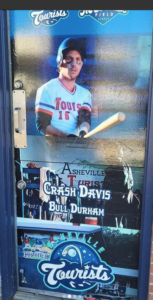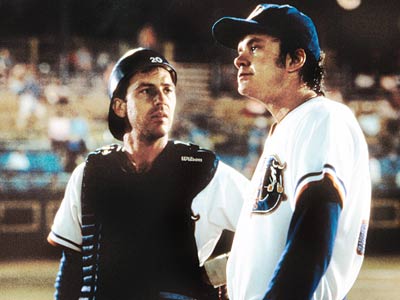You can debate whether Ron Shelton’s 1988 film Bull Durham is a rom-com masquerading as a baseball movie, or a romantic comedy disguised as a sports film.
What’s not up for debate is whether or not the Kevin Costner baseball movie has left an indelible legacy upon both sports and pop culture. At the risk of spoiling the movie (you’ve had 36 years to see it, so at this point, we’re just gonna include the spoilers without any trigger warnings) McCormick Field, home of the Asheville Tourists, has a small, but critical role in the film.
Once the main character, Crash Davis (Costner), is released by the Durham Bulls, it’s obviously time for him to retire, but he’s still short of the all-time minor leagues home run record. He catches on with the Asheville Tourists, where he breaks the mark (247) and then promptly hangs ’em up.
The baseball scenes shot at historic McCormick are few, and brief, but you can literally buy a “Crash Davis: 247 Home Runs” pin at the ballpark’s gift shop.
And if you had a choice between seeing only McCormick Field in Asheville, North Carolina or Durham Athletic Park on the other side of the state (where most of the movie’s action takes place), pick this one.
That’s because this is a very charming park (capacity 4,000) that still remains in regular use, unlike the Durham facility, which is utilized much less and thus has fallen into a deteriorated condition. If not for a Durham Bulls logo, on one side of one building, you wouldn’t even know that ballpark and the movie had any connection at all.
McCormick, on the other hand, is a venue where one gets the chance to step back in time. It’s baseball how it was back when it hadn’t sold out yet, and become majorly corporatized.
It’s a park small enough to be at the point where every single seat is a good one, and its location on a hill, and adjacent to another hill gives it a ton of added charm.
It also helps that Asheville is a much better place to visit than Durham, and hey the franchise is named the Asheville Tourists for a reason. Asheville teams have played under the Tourists moniker in different leagues and classifications for over a century, with the earliest dating to 1897. The current incarnation of the Tourists is the High A level affiliate of the Houston Astros.
People flock to Asheville mostly for the mountains (hiking trails especially) these days, with the craft breweries a close second.
The Tourists fully lean into that with their marketing and branding, but it’s worth noting that The Biltmore, the French chateau style mansion built and lived in by the Vanderbilt family dynasty, is the city’s top tourist attraction.
But McCormick Field, opened in 1924 and the third oldest ballpark still in use in MILB, is the “Tourist Trap,” just like the sign says at the entrance. McCormick Field is notable for many things, including the scoreboard which reads “Visitors” in the guest slot and “Tourists” in the home slot.
And on the day I visited, the weather was absolutely as perfect as could be, with the nearby fall foliage as defined and as aesthetically pleasing as possible. But I never found the famous mural, which was featured in the movie. Where is it?
I searched the field high and low, in all corners, so is it painted over and gone forever now?
Visited the historic McCormick Field, home of @GoTourists of Bull Durham fame pic.twitter.com/8xPzHLMeie
— Paul M. Banks (@PaulMBanks) November 9, 2021
It was along the third base side, and you can see it in the bottom life of the door that honors Crash Davis. There is also a concession stand named for him. Bull Durham, Kevin Costner or Crash Davis aren’t the only notable Asheville Tourists/McCormick Field alumni.
Eight time NFL Pro Bowler and former Super Bowl champions Russell Wilson played second base for the Tourists in 2011, the same year he set the NCAA record for single season passer rating and led the Wisconsin Badgers to the Rose Bowl.
And Babe Ruth, who was indeed fully Ruthian by the time he set foot on the diamond here, provided a ringing endorsement of the place that you can read in the photo posted in the tweet above.
Paul M. Banks is the Founding Editor of The Sports Bank. He’s also the author of “Transatlantic Passage: How the English Premier League Redefined Soccer in America,” and “No, I Can’t Get You Free Tickets: Lessons Learned From a Life in the Sports Media Industry.”
He currently contributes to Ravens Wire, part of the USA Today SMG’s NFL Wire Network and the Internet Baseball Writers Association of America. His past bylines include the New York Daily News, Sports Illustrated, Chicago Tribune and the Washington Times. You can follow him on Twitter.




